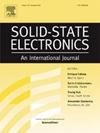Improvement of charge storage and retention characteristics of HfO2 Charge-Trapping layer in NVM based on InGaZnO channels
IF 1.4
4区 物理与天体物理
Q3 ENGINEERING, ELECTRICAL & ELECTRONIC
引用次数: 0
Abstract
In recent years, with the widespread application of semiconductor thin-film memory devices, the focus of research has gradually shifted to how to fabricate memory with larger storage windows and longer retention times. This study employs the rapid thermal annealing (RTA) method to conduct multiple annealing treatments on charge trapping memory (CTM) devices that use HfO2 as the charge trapping layer, the leakage current of the device is reduced, and the negative deviation of threshold voltage is improved. During the experiments, the charge trapping layer (CTL) and tunneling layer (TL) of the devices were deposited, and a 50 nm IGZO thin film was deposited as the channel layer. The study investigates the memory performance of TFT-NVM (thin film transistor non-volatile memory) after RTA under different conditions. The results showed that the TFT-NVM with the Al2O3/HfO2/SiO2 structure has a large memory window (1.4 V) and good charge retention (>71.39 %) before O2 annealing treatment. This provides a feasible approach for future research on TFT-NVM.
基于InGaZnO通道的NVM中HfO2电荷捕获层电荷存储和保留特性的改进
近年来,随着半导体薄膜存储器件的广泛应用,研究的重点逐渐转向如何制造具有更大存储窗口和更长的存储时间的存储器。本研究采用快速热退火(RTA)方法对以HfO2为电荷捕获层的电荷捕获存储器(CTM)器件进行多次退火处理,降低了器件的漏电流,改善了阈值电压的负偏差。在实验中,沉积了器件的电荷捕获层(CTL)和隧道层(TL),并沉积了50 nm的IGZO薄膜作为通道层。研究了薄膜晶体管非易失性存储器(TFT-NVM)在不同条件下经过RTA后的存储性能。结果表明:在O2退火处理前,Al2O3/HfO2/SiO2结构的TFT-NVM具有较大的记忆窗口(1.4 V)和良好的电荷保留率(> 71.39%);这为未来TFT-NVM的研究提供了一条可行的途径。
本文章由计算机程序翻译,如有差异,请以英文原文为准。
求助全文
约1分钟内获得全文
求助全文
来源期刊

Solid-state Electronics
物理-工程:电子与电气
CiteScore
3.00
自引率
5.90%
发文量
212
审稿时长
3 months
期刊介绍:
It is the aim of this journal to bring together in one publication outstanding papers reporting new and original work in the following areas: (1) applications of solid-state physics and technology to electronics and optoelectronics, including theory and device design; (2) optical, electrical, morphological characterization techniques and parameter extraction of devices; (3) fabrication of semiconductor devices, and also device-related materials growth, measurement and evaluation; (4) the physics and modeling of submicron and nanoscale microelectronic and optoelectronic devices, including processing, measurement, and performance evaluation; (5) applications of numerical methods to the modeling and simulation of solid-state devices and processes; and (6) nanoscale electronic and optoelectronic devices, photovoltaics, sensors, and MEMS based on semiconductor and alternative electronic materials; (7) synthesis and electrooptical properties of materials for novel devices.
 求助内容:
求助内容: 应助结果提醒方式:
应助结果提醒方式:


